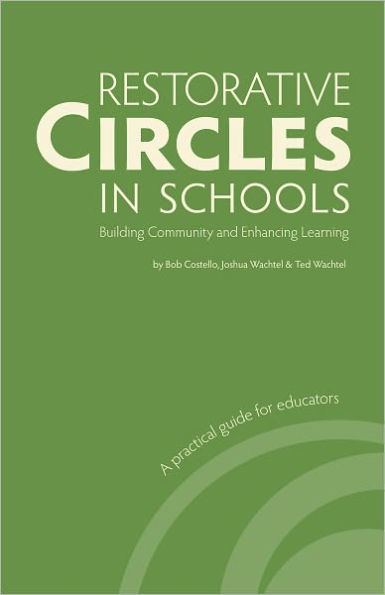Restorative Circles in Schools: Building Community and Enhancing Learning is a practical guide to the use of circles in schools and other settings, as well as an in-depth exploration of circle processes. The book includes numerous stories about the way circles have been used in many diverse situations, discussion on the use of proactive, responsive and staff circles, and an overview of restorative practices, with particular emphasis on its relationship to circle processes.
Excerpts from the book:
“I have used the circle to give direct instruction, summarize lessons, solicit student feedback and discuss various topics. By its nature, the circle allows each student to be part of the group and have direct input. No one hides in the circle.”
“The circle represents a fundamental change in the relationship between students and authority figures. It creates a cooperative atmosphere in which students take responsibility for their actions. Students respond because they feel respected and realize that what they say matters.”
“Circles provide a practical forum for the resolution of underlying feelings that intrude into the classroom and disrupt learning. The circle allows young people to express their feelings, and in doing so, reduce their intensity. The circle creates opportunities for students to recognize that others have similar issues and that they are not alone. By expressing feelings and getting acknowledgment from others, most students are then able to put their problems aside and move on with the school day.”
1112124392
Excerpts from the book:
“I have used the circle to give direct instruction, summarize lessons, solicit student feedback and discuss various topics. By its nature, the circle allows each student to be part of the group and have direct input. No one hides in the circle.”
“The circle represents a fundamental change in the relationship between students and authority figures. It creates a cooperative atmosphere in which students take responsibility for their actions. Students respond because they feel respected and realize that what they say matters.”
“Circles provide a practical forum for the resolution of underlying feelings that intrude into the classroom and disrupt learning. The circle allows young people to express their feelings, and in doing so, reduce their intensity. The circle creates opportunities for students to recognize that others have similar issues and that they are not alone. By expressing feelings and getting acknowledgment from others, most students are then able to put their problems aside and move on with the school day.”
Restorative Circles in Schools: Building Community and Enhancing Learning
Restorative Circles in Schools: Building Community and Enhancing Learning is a practical guide to the use of circles in schools and other settings, as well as an in-depth exploration of circle processes. The book includes numerous stories about the way circles have been used in many diverse situations, discussion on the use of proactive, responsive and staff circles, and an overview of restorative practices, with particular emphasis on its relationship to circle processes.
Excerpts from the book:
“I have used the circle to give direct instruction, summarize lessons, solicit student feedback and discuss various topics. By its nature, the circle allows each student to be part of the group and have direct input. No one hides in the circle.”
“The circle represents a fundamental change in the relationship between students and authority figures. It creates a cooperative atmosphere in which students take responsibility for their actions. Students respond because they feel respected and realize that what they say matters.”
“Circles provide a practical forum for the resolution of underlying feelings that intrude into the classroom and disrupt learning. The circle allows young people to express their feelings, and in doing so, reduce their intensity. The circle creates opportunities for students to recognize that others have similar issues and that they are not alone. By expressing feelings and getting acknowledgment from others, most students are then able to put their problems aside and move on with the school day.”
Excerpts from the book:
“I have used the circle to give direct instruction, summarize lessons, solicit student feedback and discuss various topics. By its nature, the circle allows each student to be part of the group and have direct input. No one hides in the circle.”
“The circle represents a fundamental change in the relationship between students and authority figures. It creates a cooperative atmosphere in which students take responsibility for their actions. Students respond because they feel respected and realize that what they say matters.”
“Circles provide a practical forum for the resolution of underlying feelings that intrude into the classroom and disrupt learning. The circle allows young people to express their feelings, and in doing so, reduce their intensity. The circle creates opportunities for students to recognize that others have similar issues and that they are not alone. By expressing feelings and getting acknowledgment from others, most students are then able to put their problems aside and move on with the school day.”
9.99
In Stock
5
1

Restorative Circles in Schools: Building Community and Enhancing Learning

Restorative Circles in Schools: Building Community and Enhancing Learning
Related collections and offers
9.99
In Stock

Product Details
| BN ID: | 2940014365840 |
|---|---|
| Publisher: | International Institute for Restorative Practices |
| Publication date: | 05/25/2012 |
| Sold by: | Barnes & Noble |
| Format: | eBook |
| File size: | 577 KB |
About the Author
From the B&N Reads Blog
